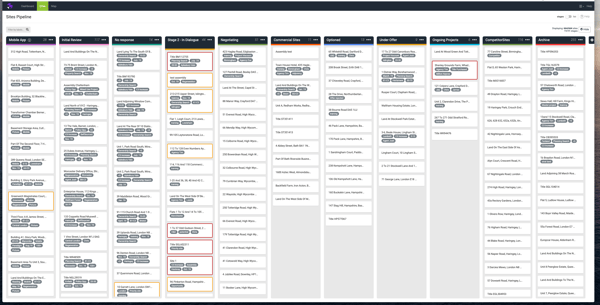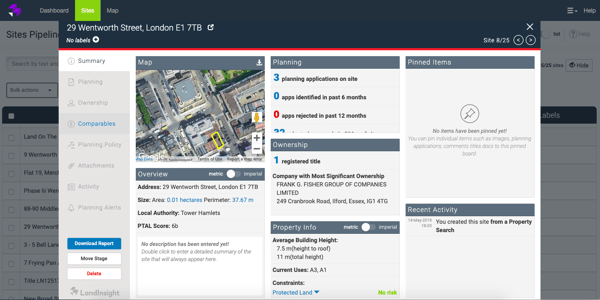Used right, the Sites Pipeline is one of the more powerful features in LandInsight. It lets you track more sites, more efficiently than ever.
So to help, I’ve put together a list of my top ten tips to get the most from your Sites Pipeline.
My Top Ten Tip for your Sites Pipeline
-
1. Use the Sites Pipeline to record, manage, and track opportunities
The Sites Pipeline is an incredibly powerful feature. But only if you’re actually using it.
Step one is simply to get used to saving sites there. It’s an efficient way to track sites in a private, secure way (we're ISO security certified so you can rest assured you're in safe hands).
If it’s not something you’re already using, start building that habit now.
-
2. Create your own stages (but try to stick to a max of around 15)
Site stages are there to make your life easier. Add more, and use them.
You can create as many as you like, but in my experience 15 or fewer is best for efficiency and consistency.
Any more and it usually gets a bit too cluttered and super specific.

-
3. Colour code your site stages for easy reference
It seems like a small thing, but you’d be surprised how much of a difference colour coding the stages will make. Everything looks clearer, and easier to use (which means you’re more likely to understand it and actually use it).
There are a few different ways this can be done – per stage of due diligence, per user, on a red-amber-green system etc. – it’s your call. But it makes a big difference in the long run.
-
4. Use site labels to make life easier
All saved sites can be easily labelled to make them easier to find.
You can use any labels you like – some common ones people find useful are:
- Date saved – to see most-active periods
- Local Authority – to get quick identification of most fruitful areas
- Site potential – to spot most fruitful/frequent projects
- Project type – to find most profitable projects and location distribution
- Origin of the site (if different from owner/user) – to track the agent/source of the site
These labels help you to review everything you’re doing. And THAT helps you to boost the effectiveness of your whole site sourcing and assessment endeavours.
-
5. Try to stick to around six labels
Technically, you can set up as many labels as you want. But, just like with sites stages, more isn’t always better.
You want to be able to spot overall trends in your labels, and creating too many labels makes that harder.
Six usually gives the right number to sort your sites without becoming cumbersome.
-
6. Move sites straight after that initial review
Once you have your initial review of a saved site, it should be moved to the appropriate stage straight away.
Of course, which stage depends on what you set up back in step two. It’ll probably be something like:
- ‘Opportunity’ – if it looks good
- ‘Archived’ – if it is to be considered later
- ‘Discarded’ – if not in consideration
Bonus tip: If you’re using the LandInsight GO app (and why wouldn’t you be?) then all sites saved will go into the ‘Mobile’ stage. Make sure you clear that stage too so you don’t miss those great opportunities you’ve found while out and about.
If you haven’t already got it – check out the app on iOS and Android.
-
7. ‘Archive’ means it’s on hold – not abandoned entirely
Some people use ‘Archive’ for those sites that may be good after future review (e.g. if there’s a change in circumstances like removal from Green Belt).
Make sure you’re using it in the right way, rather than as a place where sites with no future prospects go.
-
8. Be consistent in when you move sites through the Pipeline stages
For best results, you’ll move sites into the correct stage as soon as a change happens, so it’s always up to date.
But some people find it’s easier to save up changes and do them in batches, maybe first thing each morning, and that’s fine too.
And remember – if you create any temporary site stages, clear them by the end of the week so you’re back to your fixed stages.

-
9. You can delete sites… but you probably shouldn’t
Deleting unsuitable sites might seem smart, but it prevents a retrospective review of the process (which is what we always recommend).
In short, you’ll miss out on understanding if there’s a common source of unsuitable sites, the kind of common issues that cause unsuitability etc. Knowing all of that helps you to constantly tighten up your processes, and get better results.
For that reason, we recommend that you only delete sites when you have zero need for them now or potentially in the future.
-
10. Track your competitors too
A ‘competitor’ sites stage is just what it sounds like – a stage dedicated to keeping an eye on what the competition are up to.
You can benefit from seeing them on the map, and even get proactive updates like planning alerts (or those shiny new ownership alerts) to know what’s happening with them, and to keep tabs on your rivals.
If you haven’t already got a stage set up now’s the perfect time – those ownership alerts will mean you’ll get an email letting you know when competitors have sold sites (and you might be able to deduce a lot from when and where they’re selling…).
Manage your sites pipeline with ease
If you're already a LandInsight Unlimited user you can start implementing the tips above into your workflow to make sure you're getting the most out of the product.
Manage your sites pipeline with ease
If you're already a LandInsight Unlimited user you can start implementing our tips to get the most out of the product today.
But if you're not already a customer, and want to find out how LandInsight can help you not only organise but source new sites, click the button below.
Find out more.jpg?width=150&height=150&name=Copy%20of%20Chris%20(1).jpg)